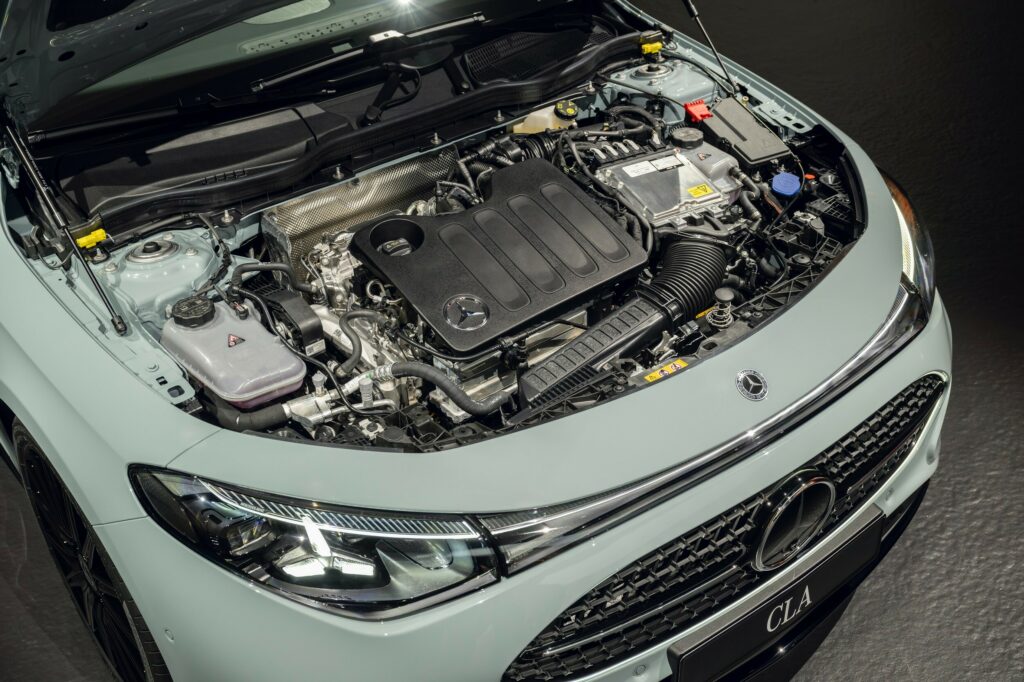GLB Model Update
Mercedes has started a teaser campaign for the new generation GLB ahead of its official premiere on December 8th. This model follows the CLA and has received a high-tech interior with the possibility of seating up to seven passengers.
Technology and Interior
Details have not yet been disclosed, but Mercedes has confirmed that the GLB will have an optional MBUX Superscreen. This system will combine a 10.25-inch digital instrument cluster with a 14-inch central infotainment screen and an identical 14-inch display for the passenger.
Buyers will also receive the latest Mercedes-Benz operating system, which includes an MBUX virtual assistant with avatars and Google Maps navigation. Widespread use of artificial intelligence is also expected.
In addition to technology, the GLB features round air vents and a floating center console. The latter contains large cup holders and available wireless smartphone charging. A new steering wheel and configurations with five and seven seats have also been introduced.
Space Improvements
Mercedes does not reveal exact figures but has stated that the updated crossover has “noticeably more headroom in the first two rows of seats.” Second-row passengers also receive additional legroom, enhanced hip support, and an adjustable backrest.
Third-row passengers have not been forgotten either – the process of getting in and out has been improved. When the rear seats are not needed, they fold into the floor of the luggage compartment.
Comfort Enhancements
A panoramic glass roof comes as standard equipment, and customers can order an enhanced version that can switch from a transparent state to a matte one in a matter of milliseconds. An illuminated roof with a “starry sky” effect is also available.
The roof also features thermal insulation glass and an infrared coating that cools the interior in summer and minimizes heat loss in winter.
Safety Systems
The GLB will receive a “comprehensive set of driver assistance systems.” They will be supported by eight cameras, five radar sensors, twelve ultrasonic sensors, and a powerful computer with performance reserves for future functions and regular over-the-air updates.
Final Testing
With less than a month until the premiere, the manufacturer is completing testing at the Mercedes Technology Center in Sindelfingen. The GLB is undergoing cold tests in climatic wind tunnels that can simulate temperatures down to -40° F (-40° C).
The tunnels have state-of-the-art snow cannons that can “simulate severe blizzards, where snowflakes move towards the test car at speeds of up to 124 mph (200 km/h).”
These tests have yielded results – the future GLB EQ heats the interior twice as fast as its predecessor during a 20-minute drive at a temperature of 19.4° F (-7° C). This reduces warm-up time compared to models with traditional engines and uses half the energy of the previous EQB.
The additional efficiency increases the driving range and is partially provided by an innovative heat pump that collects waste heat from the electric motors, the battery, and the surrounding air.
Electric and Hybrid Powertrains
Mercedes did not mention performance specifications, but the GLB EQ is likely to have an 85 kWh battery and at least two powertrains. The base version may have a rear motor with 268 hp and 247 lb-ft of torque.
An all-wheel-drive system with two motors with a combined output of 349 hp and 380 lb-ft of torque is also expected.
Customers can also expect a variety of hybrid powertrains consisting of a 1.5-liter four-cylinder engine, a 1.3 kWh battery, and an eight-speed dual-clutch transmission with an integrated electric motor. In the European CLA, this provides 154 hp and 181 hp with corresponding torque figures.

The GLB update demonstrates Mercedes’ growing focus on electrification and comfort technologies, making the model more competitive in the compact crossover market. The integration of heating systems and energy efficiency in electric versions could become a key advantage in winter operating conditions, especially in markets with cold climates.


 by
by 